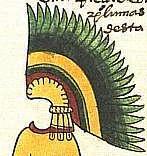
Cuitláhuac or Cuitláhuac was the 10th Huey Tlatoani (emperor) of the Aztec city of Tenochtitlan for 80 days during the year Two Flint (1520). He is credited with leading the resistance to the Spanish and Tlaxcalteca conquest of the Mexica Empire, following the death of his kinsman Moctezuma II.

Huitzilihuitl or Huitzilihuitzin was the second Tlatoani or king of Tenochtitlan. According to the Codex Chimalpahin, he reigned from 1390 to 1415, according to the Codex Aubin, he reigned from 1396 to 1417 and according to the Codex Chimalpopoca, he reigned from 1403 to 1417.

Don Diego de Alvarado Huanitzin was a 16th-century Nahua noble. A grandson of Axayacatl, Nephew of tlatoani Moctezuma II. He was initially the tlatoani (ruler) of Ecatepec before becoming tlatoani of Tenochtitlan, as well as its first governor under the colonial Spanish system of government.

Don Luis de Santa María Nanacacipactzin, also known as Cipac, was the last tlatoani ("king") of the Nahua altepetl of Tenochtitlan, as well as its governor (gobernador) under the colonial Spanish system of government. The previous ruler Cristóbal de Guzmán Cecetzin having died in 1562, Nanacacipactzin was installed on September 30, 1563, and ruled until his death on December 27, 1565.
Cacamatzin was a 15th-century Aztec noble — the eldest son of the cihuacoatl, Tlacaelel — and warrior who held the title of Tlacochcalcatl. His mother was princess Maquiztzin.

Acacitli was a Mexica chief and one of the "founding fathers" of Tenochtitlan, the capital of the Aztec Empire.
Aculnahuacatl Tzaqualcatl was the first tlatoani (ruler) of the pre-Columbian Tepanec altepetl of Tlacopan in the Valley of Mexico.

Huitzilatzin was the first tlatoani (ruler) of the pre-Columbian altepetl of Huitzilopochco in the Valley of Mexico.
Don Juan de Guzmán Itztolinqui was a post-Conquest tlatoani (ruler) of the altepetl of Coyoacán in the Valley of Mexico.

Tlilpotonqui or Tlilpotoncatzin was the second cihuacoatl ('president') of Mexico-Tenochtitlan.

Xilomantzin was the tlatoani ("king") of the pre-Columbian altepetl of Culhuacan in the Valley of Mexico from 1440 to 1473.

Antonio Valeriano was a colonial Mexican, Nahua scholar and politician. He was a collaborator with fray Bernardino de Sahagún in the creation of the twelve-volume General History of the Things of New Spain, the Florentine Codex, He served as judge-governor of both his home, Azcapotzalco, and of Tenochtitlan, in Spanish colonial New Spain.
The cabildo of San Juan Tenochtitlan was a governing council established in the 16th century to give a Spanish-style government to Tenochtitlan.
Don Antonio Valeriano, the younger was a colonial Mexican Nahua politician.

Tlatelolco was a pre-Columbian altepetl, or city-state, in the Valley of Mexico. Its inhabitants, known as the Tlatelolca, were part of the Mexica, a Nahuatl-speaking people who arrived in what is now central Mexico in the 13th century. The Mexica settled on an island in Lake Texcoco and founded the altepetl of Mexico-Tenochtitlan on the southern portion of the island. In 1337, a group of dissident Mexica broke away from the Tenochca leadership in Tenochtitlan and founded Mexico-Tlatelolco on the northern portion of the island. Tenochtitlan was closely tied with its sister city, which was largely dependent on the market of Tlatelolco, the most important site of commerce in the area.
Matlalxochtzin was a daughter of Tlacacuitlahuatzin, the first tlatoani (ruler) of Tiliuhcan, one of the polities (altepetl) of the Tepanec people in the Valley of Mexico during the Late Postclassic period of Mesoamerican chronology. She was born in Tiliuhcan after her father had been elevated as tlatoani—his father Huehuetzin had been leader in Tiliuhcan but was only of eagle warrior rank.

Itzquauhtzin was a king (tlatoani) of Nahua altepetl Tlatelolco. He was mentioned in Chimalpahin Codex.
Huehueh Quetzalmazatzin was a tlatoani (ruler) of Amaquemecan in 15th-century Mesoamerica.
Tlacuilolxochtzin was an Aztec noblewoman of very noble heritage, Lady of Ecatepec and sister of queen Tlapalizquixochtzin.












